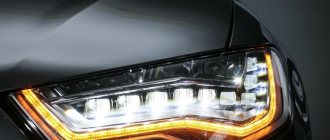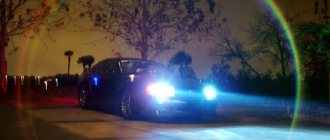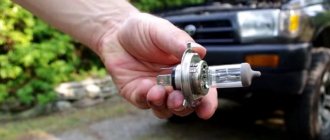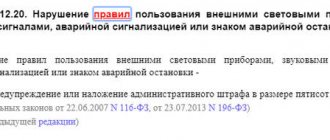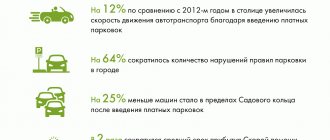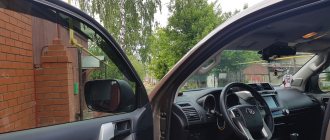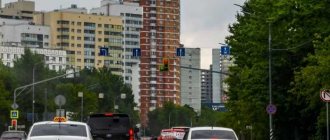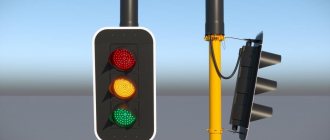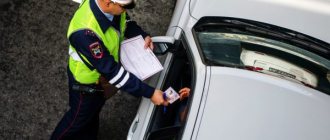Is it possible to drive without the lights on during the day?
It is forbidden. And the point here is not a lack of lamps or a malfunction of the head light. Traffic regulations directly prohibit driving at least without daytime running lights. However, let's consider all situations!
If you just forgot to turn it on
It is forbidden. Clauses 19.4 and 19.5 of the Rules collectively say that during daylight hours all vehicles must have the following on:
- or DRL,
- or low beam headlights,
- or foglights as an alternative to the above.
So, during the daytime, your car should have at least some kind of light on the front.
You will also be interested in:
- Is it possible to install eyelashes and DRLs on headlights according to traffic regulations and what is the fine for this?
- What color headlights are allowed and prohibited according to traffic regulations? Can they be tinted?
- Is it possible to install FSO flash headlights for long-range driving? What is the fine and are they deprived of their rights?
If a light bulb burns out
In this case, you are also prohibited from driving, but here we are talking about a malfunction of the light device, and the traffic rules have a separate rule in this regard. So, if you drive without bulbs in your headlights during the day, or the bulbs are burned out, then this falls under the list of malfunctions for which the operation of the vehicle is prohibited.
Clause 3.3 of the List prescribes the following:
3.3. External lighting devices and reflectors do not work in the prescribed mode or are dirty.
But paragraph 2.3.1 of the Rules indicates that if a malfunction occurs along the way, referring to this List, the driver can drive to a parking lot or to a car service center.
If there are no headlights after an accident
If the headlight is completely missing, then in this case clause 3.1 of the List of Faults is violated, namely one of its conditions prohibits driving the car both day and night:
3.1. The number, type, color, location and operating mode of external lighting devices do not meet the requirements of the vehicle design.
Please note that a violation of the integrity or inoperability of the headlight also violates paragraph 3.3 of the List cited above.
Features of using standard daytime running lights
The design of the vehicle may not provide daytime running lights on all models . As for installing them yourself, this can also lead to a fine. And even if such design changes are not identified during an inspection by a traffic police instructor, they will be discovered during a routine technical inspection. To ensure that these actions are not regarded as an offense, the driver will first need to obtain appropriate permission from the authorities to install daytime running lights. Those car models that are designed with daytime running lights can drive without fear that they will be fined.
In addition, the standard lighting system is characterized by a different operating mode - they automatically turn on when the engine starts . When low-beam headlights are activated, the standard daytime running lights contribute to a reduction in power and are used as additional dimensions.
Please note that if the standard daytime running lights are on, you cannot be fined for driving with the lights off.
Is it possible to drive without headlights at night?
Also no. Let's look at the differences in driving bans during the day and at night:
- if during the day you can use DRLs, then in the dark only low or high beams can be turned on, fog lights also cannot be turned on without them,
- During the day, if the headlight or bulb in it malfunctions, you can get to the parking lot or repair site, but at night you cannot, and there will be a fine for this.
The second point is regulated by paragraph 2.3.1 of the traffic rules, which states that in the dark, driving is prohibited if the headlight is not working, and it does not matter which headlight you are driving without - both headlights must work and be turned on.
Review. Using low beam headlights in Europe and the CIS
October 5, 2021
In most countries around the world, the use of low beam headlights is mandatory both day and night. This was done, first of all, to increase the visibility of the car for other road users.
The map below shows countries in green where the use of low-beam headlights during daytime is recommended, and purple where it is mandatory.
The use of low-beam fog lamps and clearance lamps as daytime running lights is prohibited.
Austria Low beam headlights must be used at night. During the daytime, low beam headlights should be turned on in case of limited visibility (fog, rain, snow). Fog lights can be used in thick fog, heavy rain and snow.
Belarus Obligation to use low beam headlights during the day when water quality is poor (fog, rain, snow), as well as when towing a second vehicle and transporting dangerous goods. The use of low beam headlights during the day is also mandatory for large vehicles.
Belgium Obligation to use low beam headlights at night in built-up areas. During the daytime, low beam headlights should be turned on in case of limited visibility (fog, rain, snow). Motorcyclists' headlights must be on all year round. The use of fog lights is permitted in dense fog, heavy snow or rain. Fog lights can be used alone or with low or high beams. The use of rear fog lights is permitted when visibility is up to 100 m.
UK Mandatory use of side lights in well-lit built areas, from dusk to dawn. In undeveloped or built-up but poorly lit areas, low beam headlights or road lights must be used. Foreign drivers are required to set their car lights to drive on the left.
Hungary Low beam headlights should be used in populated areas at night and during the day when visibility is limited. Outside built-up areas, low-beam headlights must be used throughout the year, both day and night, as well as on motorways. Fine – 10,000 HUF (28 €)
Germany Mandatory use of low beam headlights in case of poor visibility due to weather conditions. It is generally recommended to drive with your headlights on for 24 hours. Fog lights can be used when visibility is limited to 50 m. In tunnels, low beams must be used. Driving with side lights on is prohibited.
Spain When driving on the motorway, you must use low beam headlights, even if it is well lit. It is permitted to use side lights at night, in populated areas and on single-lane roads (provided the road is properly lit). Low beams are required in tunnels. Fog lights are a must in bad weather. If there are no fog lights, use low beam and side lights at the same time.
Italy Obligation to use low beam headlights or daytime running lights both day and night outside built-up areas and when driving through a tunnel. Every vehicle must have white or yellow lights at the front and red lights at the rear of the vehicle. Rear fog lights can only be used when visibility is limited to 50 m. Fine – 38 €
Luxembourg In populated areas, when driving at night, and when driving through tunnels, it is mandatory to use low beam headlights. The recommended use of daytime running lights is within 24 hours. In conditions of limited visibility (for example, up to 100 m), low beam headlights should be used.
Netherlands Obligation to use low beam headlights at night and during the day only when visibility is limited by weather conditions. Driving at night with side lights is prohibited.
Norway Low beam headlights must be used all year round, both day and night. Fog lights can only be used in conjunction with low beams.
Portugal Obligation to use low beam headlights at night in built-up areas; during the day - only if visibility is limited by weather conditions. When crossing tunnels and the IP5 road (main road and Aveiro/Vilar Formoso junction) on the border with Spain, low beam headlights must be used. The rear license plate must be illuminated.
Russia Low beam headlights or daytime running lights must be used outside populated areas throughout the year; in populated areas, in the evening and at night, parking lights must be used.
Romania Low beam headlights must be used in open areas throughout the year, both day and night. In populated areas, it is mandatory to use low beam headlights at night, and during the day only when visibility is limited (fog, rain, snow).
Slovakia Low beam headlights must be used all year round, both day and night. Fog lights can be used in cases of limited visibility (fog, rain, snow).
Slovenia Obligation to use low beam headlights in open areas throughout the year, both day and night. Fog lights can be used with visibility up to 50 m.
Ukraine Low beam headlights must be used day and night from October 1 to April 30.
Finland Low beam headlights must be used all year round, both day and night. Fog lights are optional and their use is only permitted in poor weather conditions. Fog lights should be used in conjunction with low beam headlights.
France In undeveloped areas, it is recommended to use low beams both day and night.
Croatia Low beam headlights must be used at night, and during the day only when visibility is limited (fog, rain, snowfall). In winter, from the last Sunday in October to the last Sunday in March, the use of light is mandatory for 24 hours.
Bosnia and Herzegovina, Bulgaria, Montenegro, Czech Republic, Denmark, Estonia, Lithuania, Latvia, Serbia, Switzerland, Sweden - low beam headlights must be used all year round, both day and night.
Based on materials from the site https://www.pzmtravel.com.pl/ and other Internet sources
What's the fine?
Since most of the above standards refer us to the List of Faults, responsibility must be taken precisely for this. And it is provided for by the only punishment in the Code of Administrative Offenses for violation of any of the conditions and malfunctions prohibiting the operation of the vehicle.
Part 1 of Article 12.5 of the Administrative Code provides for a fine of 500 rubles or a warning for this. Penalties are imposed for the following violations of the use of light:
- there is no headlight both at night and during the day,
- The headlight bulb is burned out or missing.
Art. 12.20 of the Code also prescribes a fine of 500 rubles or a warning for violating the use of lighting devices. It is prescribed for the following violations:
- you didn't turn on the DRL during the day,
- you are driving without lights at night.
This penalty is imposed if the lighting devices are in working order.
Fine for driving high beams in the city
Another popular rule violation is improper use of high beam headlights. High beam cannot be used:
- in populated areas on illuminated roads;
- when passing oncoming traffic with another car (at a distance of less than 150 meters);
- in other cases, if it can blind drivers of passing or oncoming cars.
Most often, a fine is imposed specifically for using high beams in the city. It represents a warning or 500 rubles .
If the headlight stops working while on the road
As we have already indicated above, traffic rules allow the possibility of driving to a parking lot or repair site if a malfunction occurs along the way. And before driving, the Rules oblige the driver to check the operation of the car for all the conditions of the List of Faults.
Therefore, if, when stopped by a traffic police inspector, you state that a condition entailing a violation arose along the way, and you proceed to the place where you can eliminate the deficiency, then it is unlawful to issue a fine.
But if you are driving without a headlight at night, then in any case the fine is legal, since in the dark it is forbidden to continue driving without low beam working in the established mode. In this case, according to the letter of the law in 2021, you are obliged to call a tow truck or have the car towed.
In addition, this provision with a fine for driving without low beams applies not only to the dark, but also to conditions of insufficient visibility: fog, rain, snow and other conditions with road visibility of less than 300 meters.
Is it possible to drive without dimensions?
Only possible during the day. The rules do not directly prohibit driving without side lights in the daytime, but at night this is prohibited by paragraph 2.3.1 of the traffic rules.
Moreover, at night, traffic regulations require at least low beams to be turned on. And by design, on all cars it turns on only when the dimensions are turned on. Therefore, you won’t be able to travel without them. And if the latter are faulty, then in the dark you will be fined 500 rubles, and movement to the parking lot or repair site is prohibited.
Something else useful for you:
- All about the fine for low beam: what size is it if the headlights are not turned on or do not work?
- Is there a penalty for driving with a broken, broken or cracked windshield and what is it?
- How much are fines for wheels and tires? All possible violations
What is the penalty for violating the rules?
Illegal use of lighting devices is classified under Art. 12.20 of the Code of Administrative Offences, as a violation and is punishable either by a warning or a fine of 500 rubles .
This is important to know:
What is the penalty for missing a thorn sign?
What fine is imposed if you have no insurance?
What is the fine for speeding
If you are driving with a broken or burnt-out headlight, then you face the same amount of punishment, only it is provided for in Part 1 of Art. 12.5 and is considered as the use of a vehicle in the presence of breakdowns, driving with which is prohibited. That is, the fine for a non-working headlight will be equal to 500 rubles .
If you decide to add some “zest” to your car and
install lighting, for example blue, in the headlights, dimensions, daytime running lights, or decide to illuminate the state lights. number, then this will be a violation .
Clause 3.6 of the “Basic provisions for the admission of vehicles...”, approved by Government Decree 1090 of October 23, 1993, determines what color the headlights should be, both front and rear.
On both sides it can be either orange or yellow. For the headlights located at the front of the car, white is acceptable, and for the rear ones, red.
To allocate state Numbers can only be used in white. If the color differs from those mentioned above, then operation of the vehicle is prohibited.
For this type of violation, very serious liability is provided for, Part 3 of Art. 12.5 of the Code of Administrative Offences, deprivation of rights for a period of six months to a year and confiscation of such devices.
Features of bringing to responsibility
Almost all articles of the Code of Administrative Offenses provide for a variation in the amount or options of punishment. The amount of the fine you will have to pay depends on the degree of guilt and the consequences that the offense led to and its repetition.
If driving without lights during the day occurred for the first time, then the minimum penalty is applied. For the purposes of administrative liability, an offense committed at least 2 times during the year is considered repeated. That is, most likely you will get off with a warning.
If you left for the first time with the lights off during the day, but do not hide the fact that you did not turn them on intentionally, then, most likely, you will still be fined for not turning on the headlights. The inspector is also a person, so polite communication with government officials will always benefit you, first and foremost.
If the lack of lighting devices led to a collision with a pedestrian, then your offense will be considered as an aggravating circumstance when deciding whether to apply administrative measures to you in the case of a collision with a pedestrian. Read here what rules exist for crossing the road for pedestrians.
If you get into an accident , even if it seems to be not your fault, then in addition to the fine for the unlawful use of lighting devices, you will suffer another disappointment. Responsibility for the collision will be divided equally between the person at fault and you. Accordingly, the amount allocated for insurance repairs will be half less.
If you are nevertheless issued a fine, you must pay it within 2 months . You can do this in any way available to you: contact the bank with a resolution or pay electronically using the details specified in it. If you fulfill your obligation within the first 20 days, the amount of the penalty will be halved.
This relief is provided for in Art. 32.2 Code of Administrative Offences. This rule does not apply to all offenses that may occur on the road, but it does apply to light violations.
How to avoid punishment
The likelihood of avoiding punishment will depend on the specific type of offense. If you forgetfully did not turn on the low beam during the day or one of the bulbs burned out on the road, it is likely that you will get off with a warning.
But you need to understand that if a situation arises with a burnt-out light bulb, then according to the rules of clause 2.3.1 of the Traffic Regulations, the driver must take measures to eliminate the malfunction on the spot or, taking into account all possible precautions, go to the parking lot or to a service center to fix the breakdown.
If you are stopped by a traffic police officer, the best way out would be to politely remind him of the alternative punishment in this case, and swear to assure him that it is the service that you are going to.
You cannot move in the dark or in conditions of limited visibility without light. Fortunately, the lack of lighting in such conditions is much easier for the driver to notice. Therefore, it is unlikely that it will be possible to avoid punishment.
But if you use non-standard lighting devices, the use of which is not provided for by traffic regulations, then you will definitely not be able to avoid liability. An administrative violation report will be drawn up against you, followed by deprivation of your rights.
Read about how to challenge the actions of a traffic police officer in the following articles:
How to complain about an inspector.
How to appeal a decision
Can I install a headlight from another car?
If you don’t have a headlight at all after an accident or it’s faulty, then using another car is possible, but only in 2 cases:
- another headlight from the same model as your car, including having the same markings and designed for the same light source (halogen, xenon, for example),
- your car is no longer in production, but then the headlight from another car should also match the type of lamps used in your stock one.
If everything is very clear with the first option, then the second is permitted by paragraph 3.1 of the List of Faults as an exception.
If your car model is still in production (namely a model, not a generation or modification), then installing another headlight will be a change in the design, which is prohibited by the Rules. In particular, paragraph 7.18 indicates that operation is prohibited if changes are made to the design. And paragraph 6 of the Technical Regulations of the Customs Union says what changes to the design are.
For this you can receive not only a fine, but also the cancellation of your car registration.
